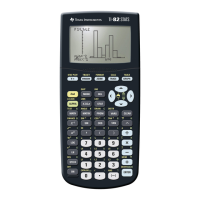4-2 Parametric Graphing
82EB1A~1.DOC TI-83 international English Bob Fedorisko Revised: 10/26/05 1:20 PM Printed: 10/27/05 1:58
PM Page 2 of 8
Getting Started is a fast-paced introduction. Read the chapter for details.
Graph the parametric equation that describes the path of a ball hit at an initial speed
of 30 meters per second, at an initial angle of 25 degrees with the horizontal from
ground level. How far does the ball travel? When does it hit the ground? How high
does it go? Ignore all forces except gravity.
For initial velocity v
0
and angle q, the position of the ball as a function of time has
horizontal and vertical components.
Horizontal: X1(t)=tv
0
cos(q)
Vertical: Y1(t)=tv
0
sin(q)N
1
2
gt
2
The vertical and horizontal vectors of the ball’s motion also will be graphed.
Vertical vector: X2(t)=0 Y2(t)=Y1(t)
Horizontal vector: X3(t)=X1(t) Y3(t)=0
Gravity constant: g=9.8 m/sec
2
1. Press z. Press † † † ~ Í to select
Par mode. Press † † ~ Í to select
Simul for simultaneous graphing of all three
parametric equations in this example.
2. Press o. Press 30 „ ™ 25 y
[
ANGLE] 1 (to select ¡) ¤ Í to define X1T
in terms of T.
3. Press 30 „ ˜ 25 y [ANGLE] 1 ¤ ¹
9.8 ¥ 2 „ ¡ Í to define Y1T.
The vertical component vector is defined by
X2T and Y2T.
4. Press
0 Í to define X2T.
5. Press ~ to display the VARS Y.VARS
menu. Press 2 to display the PARAMETRIC
secondary menu. Press 2 Í to define Y2T.
Getting Started: Path of a Ball

